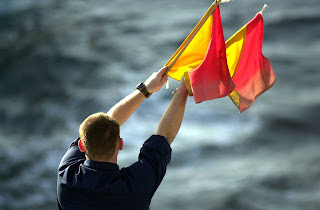- The word semaphore comes from the Greek words for "sign bearer".
- One of the earliest forerunners of semaphore as we know it was devised by Anglo-Irish landowner and inventor, Sir Richard Lovell Edgeworth in 1767. He used it to transmit the results of Horse races, having had a bet with his friend Lord Marsh that he could transmit knowledge of the outcome of the race in just one hour, using a series of signal stations.
- A similar system with a more serious use was devised in 1790 by Claude Chappe and his brothers in France. They saw a need for a rapid means of communication between allied troops. It was Claude Chappe who came up with the word "semaphore" to describe such a system. The first message was sent on 2 March 1791 at 11am, and it was: “si vous réussissez, vous serez bientôt couverts de gloire” (If you succeed, you will soon bask in glory) over a distance of 16 kilometres (9.9 mi).
- By the following year, a line of semaphore stations had been built which could carry messages between Paris and Lille, 230 kilometres (about 143 miles) away, in about an hour. Needless to say, the speed at which messages could be transmitted varied with the weather.
- In 1795, the British Admiralty took up the system as well, with Lord George Murray proposing and setting a system based on the ones in France. The first semaphore line in Britain was between London and Deal in Kent, and consisted of 15 stations. It took about 60 seconds to pass a message from London to Deal.
- Semaphore towers had their limitations as means of military communication, however. The messages weren't exactly secret - anyone who could see the tower could intercept the message, and it was pretty useless on a foggy day or at night. They were in due course replaced by telegraph machines, Radio and the internet, but signalling by means of a person holding flags is still used by the Navy, in particular when ships are refuelling or exchanging supplies while at sea.
- Official semaphore Flags are a different colour at sea than those used on land. At sea, the flags are colored Red and Yellow (the Oscar flag), while on land, they are White and Blue (the Papa flag).
- In semaphore, each letter of the alphabet is represented by a position of the arms. There are also signals to specify whether letters or numbers are being transmitted, to attract attention and to communicate that the message is complete and the other person can now send a reply. In Japan, they use a writing system consisting of many more symbols than there are letters in the Latin alphabet - so the Japanese use their own system which requires two or even three signallers to convey each symbol.
- The Peace symbol, adopted by the Campaign for Nuclear Disarmament in 1958, is based on semaphore. It was designed by Gerald Holtom and incorporates the semaphore letters "N" and "D" (for nuclear disarmament) enclosed in a circle.
- Originally, The Beatles wanted the cover of their album, Help! to depict the four members of the group using their arms to spell out the word "Help" in semaphore. However, from a design perspective, the combination of arm positions was deemed aesthetically unpleasing. The positions the Beatles hold their arms in on the album cover is therefore meaningless, but looks better.
I write fiction, too! My characters include some British superheroes and a psychic detective. You never know, your new favourite could be here! You won't know unless you look...
Browse other topics I've covered in this blog - HERE.
Like my Facebook page for news of Topical Ten posts, posts on my writing blog, and news of upcoming publications. |


No comments:
Post a Comment